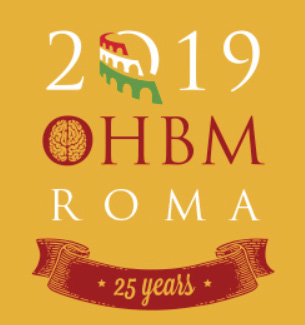
What a special time in Rome we had over the June 9-13 period for the Organization for Human Brain Mapping [OHBM] annual scientific meeting! This one was the 25th anniversary of the meeting & was my last year [of a 3 year stint] on the Program Committee. For planning the meeting 3 years ago, OHBM Council originally was expecting ~3,000 people. In reality, 4100 people showed up to the meeting!!! A staggering number of people – stretching everyone & everything to the limit. So here are some selected highlights from the meeting, from my own very limited perspective – for those of you interested in travel stuff, keep reading as there is something here for you too.
The meeting was held at an interesting location – the Auditorium Parco Della Musica – a set of 3 concert halls & associated facilities. The architecture is interesting & the complex consists of 3 giant pods or beans [see picture below], which were completed in 2003. The contract was completed by Renzo Piano & Renzo Piano Building Workshop, after being approved in 1994. Invariably, construction on the project was delayed due to the discovery of archeological artifacts at the site – not surprising, it is Rome after all. For more details on the facilities, history & museums on site in the place [https://www.auditorium.com/].
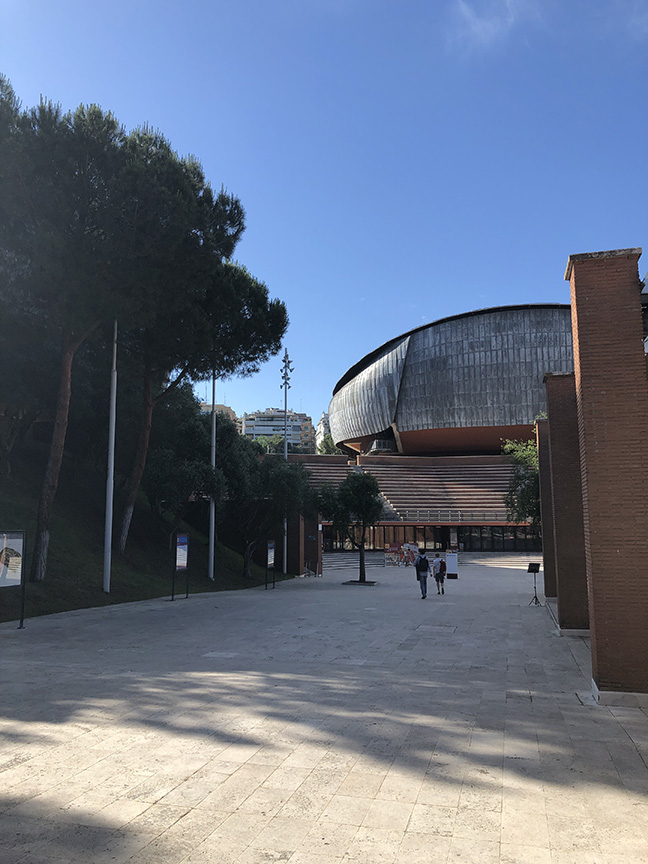
The site did have a lot of stairs – for me personally, this was a good thing: since I sat so much in talks & meetings, it was a good way to get up my step count each day… My favorite part of the place? The Musa Room to be sure – with it’s large collection of musical instruments lining both sides of a long access corridor…
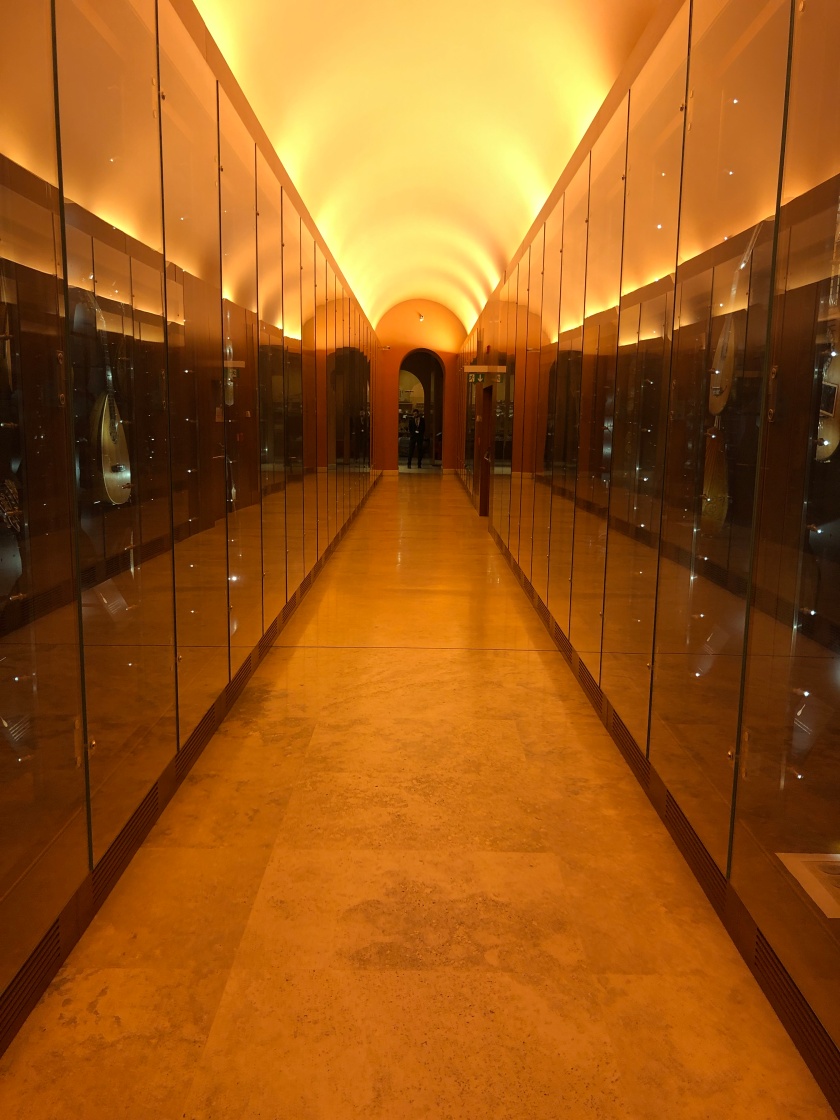
…which included a Stradivari from 1690 – the so-called ‘Tuscan violin’! Looked as if it had been made yesterday!
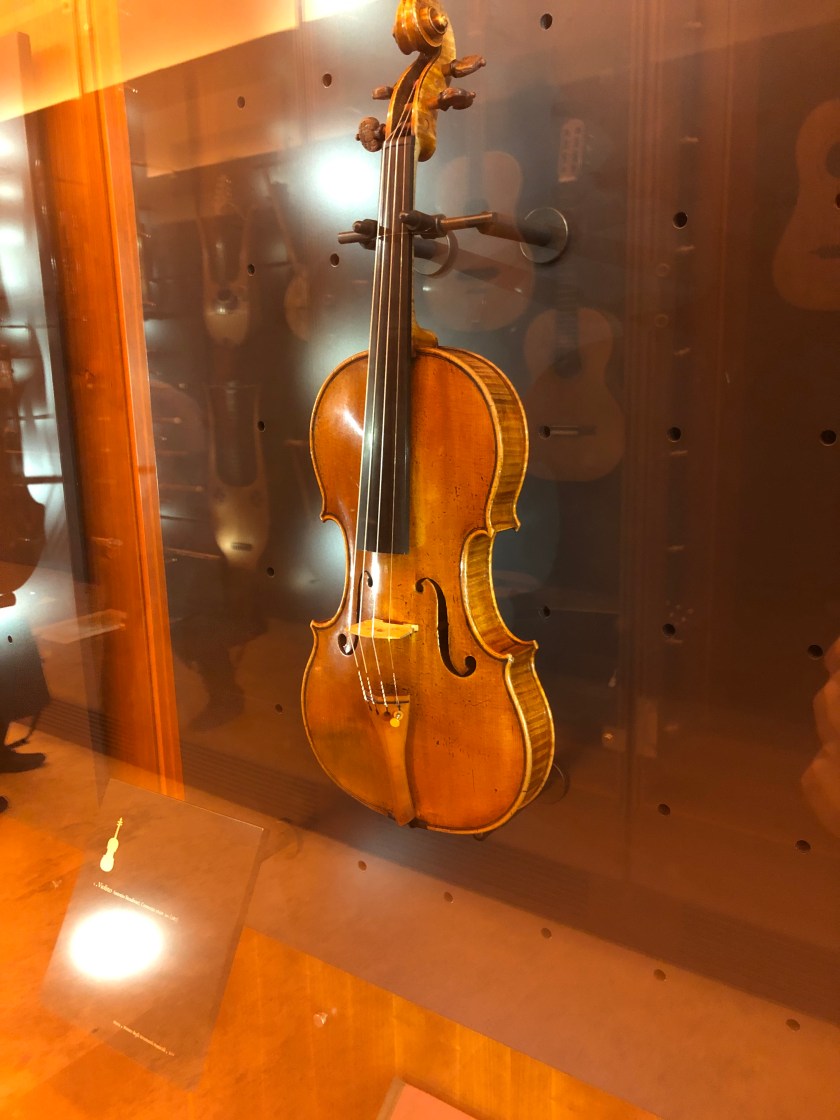
The collection of musical instruments was very beautiful & included all types – string, wind, percussion etc. It also included some interesting folk music instruments as well.
And also a musical instrument laboratory.

The OHBM opening ceremony with awards etc. was one I will never forget. It started the meeting off with usual Italian style! Four shapely divas walked on stage & sang a few popular Italian songs & then an opera aria. Their voices were divine! Our own OHBM2019 Local Organizing Committee Co-Chair Emiliano Ricciardi joined them in a wonderful display of his own operatic talent. Indeed, it was the topic of many OHBM conversations for the entire week! Here is the video that I shot that Bernard Mazoyer also ended up showing at the closing ceremony.
Back in February, we had the Program Committee meeting [in Montreal checking out the next OHBM meeting site]. At dinner after a really long day working on the program for Rome we were all very tired. Instead of the usual science banter which often happens at these organizing dinners, we ended up talking about our hobbies & interests. I was sitting opposite the Local Organizing Committee Co-Chairs – Emiliano & Pietro Pietrini. Emiliano mentioned that he sung opera & I suggested that he sing at the OHBM Welcome reception. I noticed that Pietro had an evil glint in his eye: I am not sure now if they had already cooked up the plan for Emiliano to sing at the Opening Ceremony, or whether at that point in time Pietro had that idea. Either way Emiliano’s wonderful performance is part of OHBM history! It will certainly be a hard act to follow for Alan Evans in Montreal next year…
I was really looking forward to Riitta Hari’s Talairach Lecture on Sunday night. Prior to that on the Saturday evening the 2 of us splurged on dinner at a fabulous restaurant in Rome called Mirabelle [see https://www.mirabelle.it/]. It is housed on the 7th floor of a very swish Roman hotel with a terrace that overlooks the city of Rome. It has one Michelin Star, so as you can imagine everything was spectacular… Here are some pics of us & some of the dishes we had. We washed that gorgeous food down with a top-end Sancerre from the Loire Valley. Needless to say my credit card was smoking for a couple of days after paying half the bill, but it was worth it!
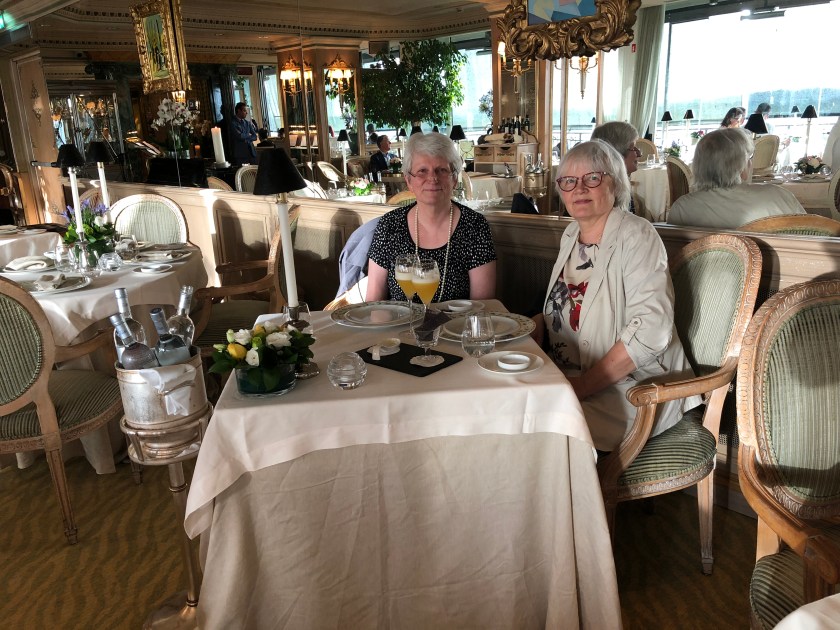
Of course, the presentation on the dishes was exceptional. The image above of that green apple is deceptive: inside was a foie gras pate encased in a green apple jelly. The apple was completely soft, so I would really love to know how it was assembled. That restaurant had the type of cooking that would be impossible to duplicate in your own kitchen. I love to cook, but that is a thousand levels beyond my skill level…
The next evening, Pietro Pietrini welcomed us at the Opening Ceremony & Alan Evans was awarded the Glass Brain Award. Very well deserved to be sure – I was surprised that he had not won it earlier actually. [Next year Alan will be the Local Organizing Committee Chair for the meeting in Montreal.] The Early Career Investigator award went to Thomas Yeo – it was nice to see the congratulatory messages making their way to Thomas on social media!
And then for the main event of the evening: Riitta Hari completed her Keynote entitled: ‘Timing Matters‘. Riitta also paid tribute to the late Prof. Fernando Lopes da Silva, who died in May of this year. He was known as a giant in the EEG field & was an long-time editor of a book we all call ‘The EEG Bible‘ for short. I used it in its 2nd edition when I was a graduate student. The most recent edition came out in February 2018 [see https://oxfordmedicine.com/view/10.1093/med/9780190228484.001.0001/med-9780190228484]. Fernando was a very kind individual, as well as being a stellar scientist. My interactions with him [of which there were not many] were always wonderful. Indeed, he did Riitta & I an extreme kindness by writing a short review on our MEG-EEG Primer that we have featured on our back cover. The EEG & MEG community sorely feels the loss of this ‘Father of EEG’ – everyone was talking about this at OHBM…
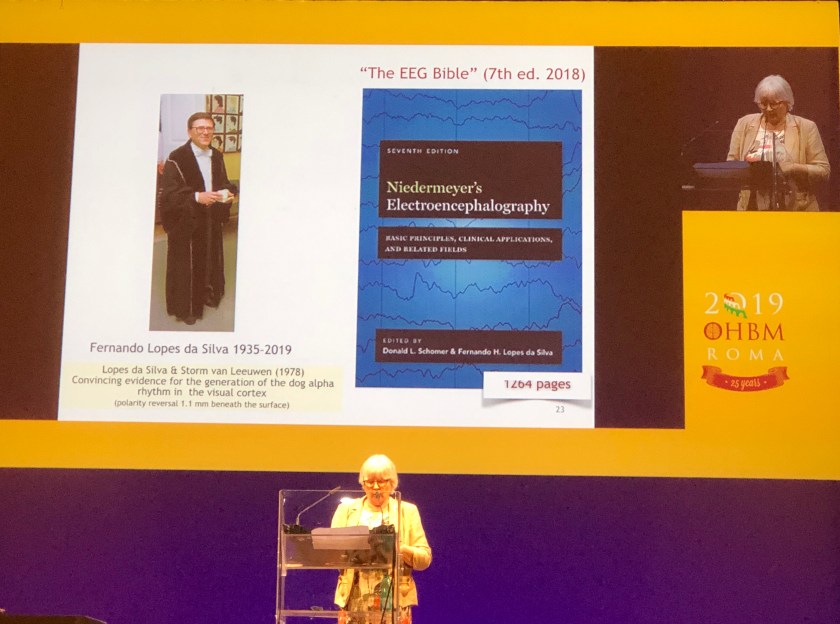
During her Talairach lecture, Riitta took us on a trip back to the days of single channel MEG technology. How far the field has come since then! She then developed the idea that observed differences in MEG/EEG & fMRI signals might arise due to different biases the 2 methods might have to measure neural output produced by different fiber sizes. For example, when one looks at the diameter of callosal fibres, it is not even across the corpus callosum – average diameter varies as a function of anatomical position [Aboitiz et al., 1992], resulting in inter-hemispheric transfer times that can vary from 3-300 ms.
Despite some issues with a collapsing lectern, Riitta was unflappable & continued on as if nothing had happened… It struck me that the content of her slide at the time was somewhat ironic too.
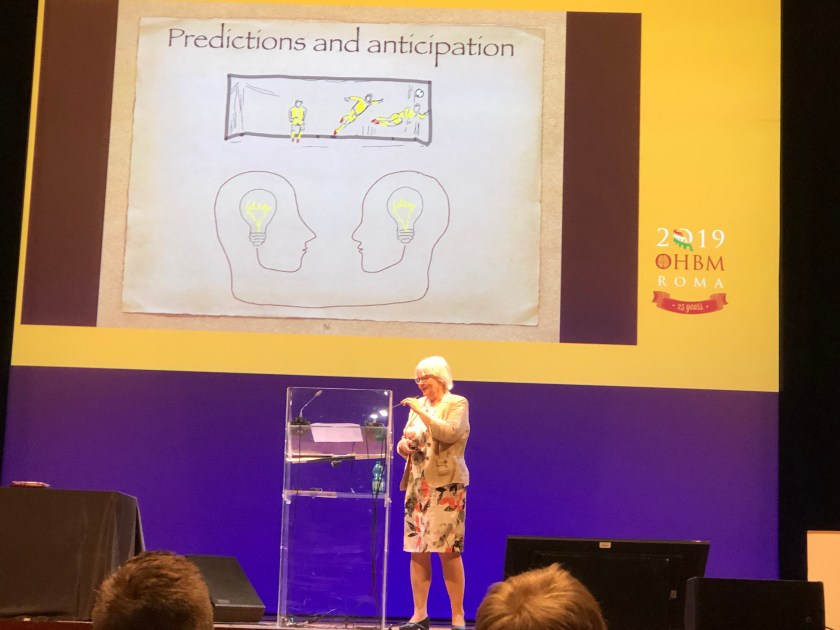
So, the take home message of the lecture was that it is likely the MEG/EEG & fMRI see outputs from different fibers. Specifically, MEG/EEG signals more likely are biased by the neuronal ensembles that send their outputs to large fibers [fast timing], whereas the fMRI signal is more likely to arise from signals reverberating in small & medium fiber systems. So this is an interesting idea – something that was discussed afterwards in the reception & all week long during the meeting. The lecture has seeded some germs of ideas for testing over the next few years – serving its purpose well. After, the lecture we retired to the outdoors to catch up with old friends & make new ones for the outdoor reception with lovely food, drinks & entertainment Italian style!
Monday morning we were off to a wonderful start. It was my great pleasure to introduce Dani Bassett – the 1st of our keynotes for the 25th anniversary meeting. Dani’s lecture was a technological & scientific tour de force. [Indeed, who could expect her to do otherwise?] Before her keynote the two of us were chatting on stage & as we looked out onto the audience in the auditorium my photographer instinct seized me. The view was fabulous from the stage – here is our view from there. I already shared this one on social media, so apologies if you have seen it already.
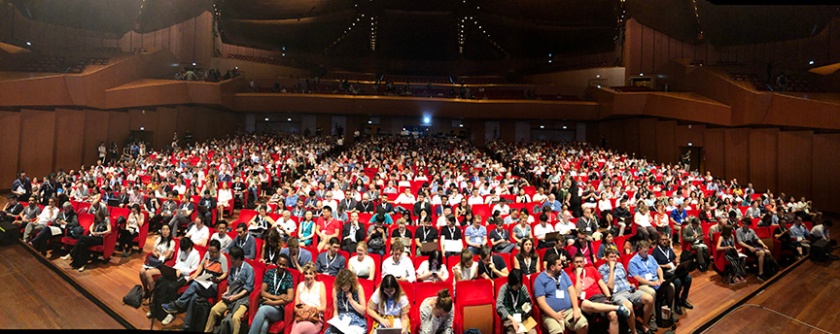
And here is a selfie of us on the stage before her lecture & then me introducing the lecture [pic courtesy of Andreas Horn – thank you].
Finally, here is a pic by Franco Pestilli [thank you] from the ‘nose bleed’ section of the auditorium while Dani is giving her talk – we look like ants on that stage. A few days later I was up in the second balcony to listen to a keynote when the downstairs part was full. It is truly wonderful to look out & see so many neuroimagers – with 60% of them being trainees – graduate students & post-docs. How our field has grown in 25 years!
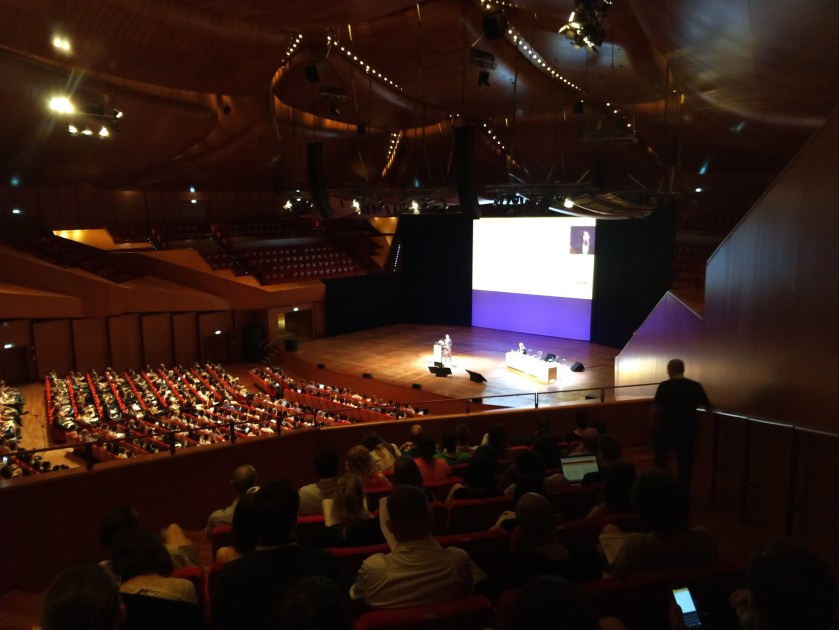
One of the special events this year, given our 25th anniversary, was a Symposium entitled: ‘A retrospective look back at OHBM‘ which was live streamed & I believe is now available on OHBM On Demand for our members. It was organized by Peter Bandettini & had sixteen scientists on stage who had been involved with OHBM from the first years. Here are a couple of pics of everyone on stage.
In the image on the left Peter B is at the podium. Seated [closest to camera] are Karl Zilles, Karen Berman, Susan Bookheimer, David Van Essen, Bob Turner, Alan Evans & Art Toga. In the image on the right we have [unseen] Peter Fox, me & Riitta Hari, then closest to camera is Bernard Mazoyer, Arno Villringer, Bruce Rosen, David Kennedy & Rainer Goebel. Missing from the meeting were people such as Jim Haxby, Leslie Ungerleider, Karl Friston, Kia Nobre, Greg McCarthy, Marcel Mesulam & many others. We paid tribute to the late Keith Worsley & Jack Belliveau – two scientists who contributed major methodological advances to our field. We spent time reflecting on the first Paris meeting & the various significant events in the meeting since that time. Not sure how the audience felt, but we all enjoyed it immensely! Karl Zilles actually christened it the ‘Dinosaur Symposium‘ – somehow it got attributed to me at the Closing Ceremony – probably because I had broadcast it on social media. But it was not my invention.
I managed to take a couple of decent iPhone panoramas of Rome Monday afternoon & evening – one was taken from the Capitolini Museums [see https://en.wikipedia.org/wiki/Capitoline_Museums] – a museum complex that I really love & have visited on a previous visit to Rome. So many ancient treasures to see here!
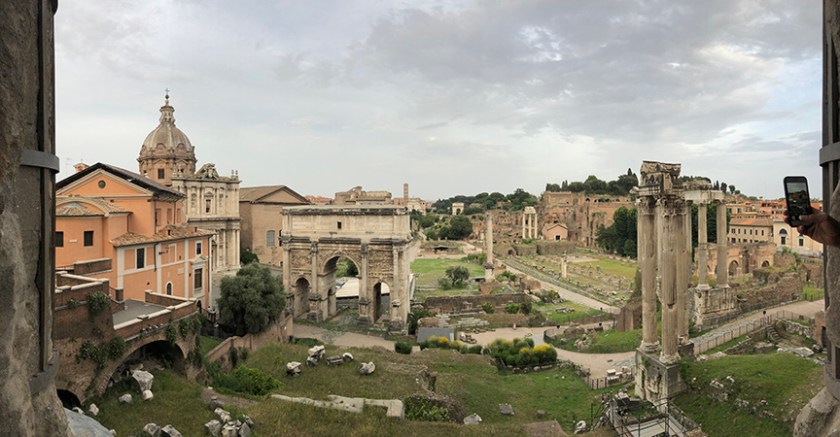
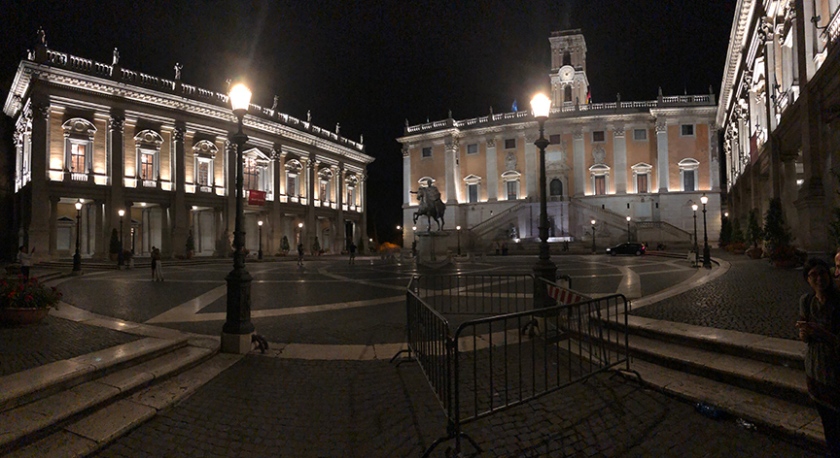
Speaking of art & culture – OHBM Art Exhibit grows every year & the works are also very interesting & stimulating to look at. I always make sure that I get to it early – do not want to miss it as I get busier towards the end of the meeting. Here are a couple of the pieces that resonated with me personally the most.
Next to the art exhibit ppl could take time out for relax & also play the piano. Here is an OHBM attendee relaxing & providing a pleasant ambience for others…
On Tuesday I went to the Aperture Round Table – organized by JB Poline & Nikola Strikov. Good to see OHBM’s publication platform in forward motion & there were lots of good suggestions for future action. We were fortunate to be in the Choir Hall & everyone enjoyed having that harpsichord in the room after the end of the session. You can see the string vibrate here in the video when the key is struck.
Tuesday night was the NeuroImage Editorial Board dinner – always a chance to catch up with people you might have not seen for a while – like Sonja Kotz, in the image below [kindly taken by Til Ole Bergmann].
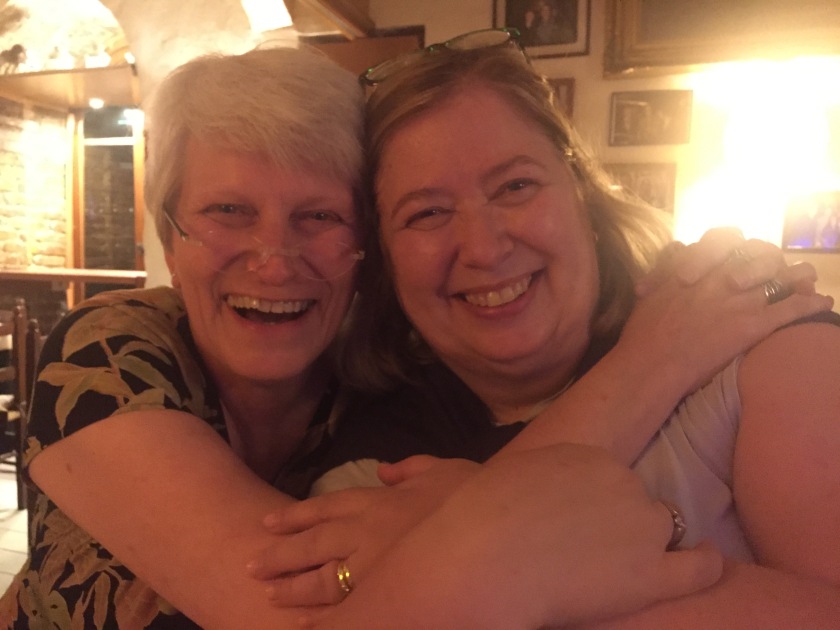
Another unique thing about the OHBM2019 meeting was the special postcard & stamp that had been prepared for the 25th anniversary. The postcard features the logo for the meeting – which is visible in the background when I am introducing Dani Bassett in an earlier image in this post. The Italian Post ppl were only too happy to give me an extra stamp on my postcard 🙂
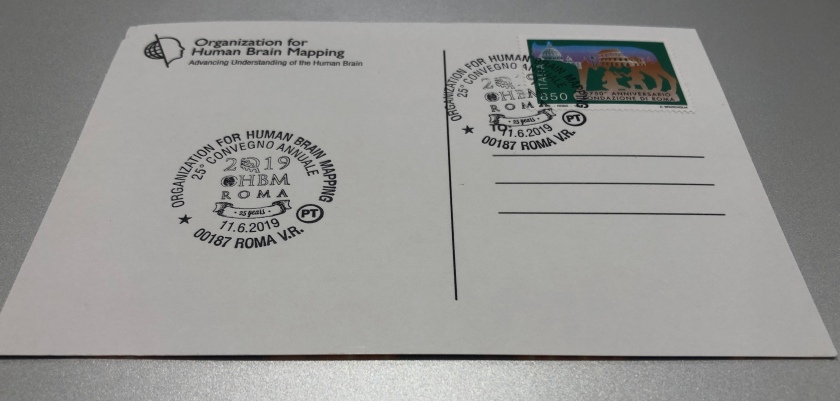
But then it was time to get serious: time for the Program Committee meeting. We discussed what was good, what was bad & what we need to make the meeting better for next year. [Same thing to be said for the OHBM Council meeting. I have just rotated onto Council as OHBM Chair-Elect.] What was unfortunate this year was that the poster hall was very hot & airless – made unbearable by the heatwave we had in Rome during the OHBM meeting. I walked through the entire area a number of times – it seemed like those who were at the entrance & the middle were roasting & those who were right down the very end could at least get some cool breeze from the open doors leading to the car park. There was also not really enough space for people – an artifact of expecting 3,000 people & having over 4,000 show up… The video shows the bustle in one of the poster sessions:
We are going to have to make sure that we have some flexibility to expand our space so that the same thing does not happen in future. I have to say, I had flashbacks to previous OHBM meetings when I walked through that hot poster area – flashbacks to that first Paris meeting & to the meeting in Florence. The poster sessions are the scientific lifeblood of our meeting, so we need to really get this right… I gather that this was [justifiably] a hot issue [pardon the pun] at the OHBM General Assembly & Feedback Forum on Wednesday afternoon. I really wish I had been there to hear all of the discussion. Unfortunately, at that same time I was presenting in a Symposium on the ‘Neural basis of the human consciousness: Phenomena, paradigms & exploring techniques‘ at La Sapienza organized by Claudio Babiloni in conjunction with the Global Brain Symposium [with Alan Evans chairing]. So ironically, we were hotly debating consciousness while OHBM Members were debating the heat…
Here are a few pics from La Sapienza Symposium that I took – with Claudio Babiloni & Margitta Seeck presenting. I was also a presenter.
As we were having our panel discussion at the end – running a bit late – we had one of the policemen from the University Police come & tell us to finish up so that he could lock the building. We managed to get another 15 minutes of discussion before being dismissed by the long arm of the law… Thanks to one of Claudio’s students who took the picture below.

We then retired for a tour of La Sapienza campus, kindly given to us by Claudio Babiloni. La Sapienza [see https://www.uniroma1.it/it/pagina-strutturale/home] is a walled city housing many, many buildings & that is home to about 100,000 students! Here is a map of the institution – it is huge.
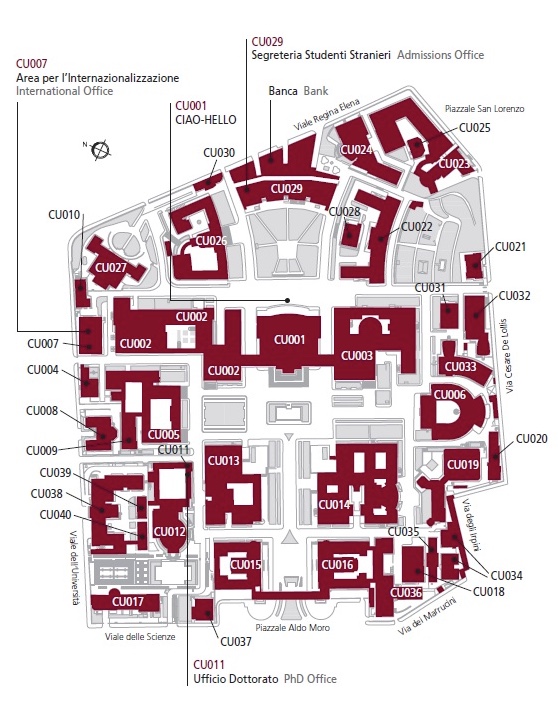
The front entrance is pretty impressive & monumental – reflecting the pared down architectural style that was popular during Mussolini’s rule. The image following is La Sapienza’s logo.
Another particularly monumental building is the one which houses the university’s rector.
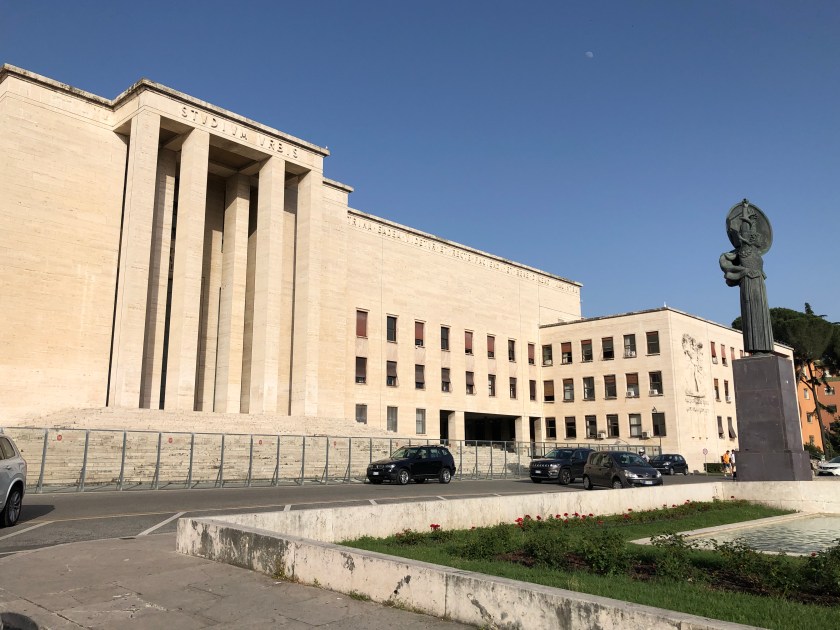
In front of that building is a huge statue of Athena – the Goddess of Knowledge – in front of a pool of water. Apparently the students avoid Athena’s gaze, or indeed the reflection of her eyes in the water, when they are on their way to an exam. Superstition has it that if one looks directly into the eyes of the Goddess of Knowledge then one will surely fail the exam. So students walk past it with their heads down. At this time of year I did not see any students, but that would be something interesting to see for sure…
It started out as a bit of a joke when Claudio initially suggested we do the Symposium – I said OK if he was springing for dinner… So he did. He was a wonderful host – he took us out to dinner along with his students to a club that was associated with La Sapienza. Dinner was marvellous – lots of great seafood & fish washed down with a lovely Italian dry white wine. Always happy to sing for my supper if it is going to be like that!!! Thank you Claudio…
The closing ceremony of OHBM was interesting because this time Bernard Mazoyer, in his position as the past Chair of OHBM Council, had to do the obligatory look back at the current meeting. As fortunate coincidence would have it, he was the organizer of the very first meeting in Paris. Therefore he chose to reflect on looking for ‘seeds’ of the work of the here & now in the early days of the meeting. And indeed, there it all was, albeit in its infancy – work on white matter tractography, functional connectivity etc. among those those 440 abstracts. It was wonderful to see how our field had grown over the years – not only with respect to techniques, but relative to the science as well. My own abstract was a combo intracranial EEG & functional MRI study on face perception.
As is usual in the closing ceremony, we take a look forward to the next meeting. OHBM 2020 will be in Montreal & Jia-Hong Gao will be OHBM Council Chair & Alan Evans [the Glass Brain Recipient] will be the Co-Chair of the Local Organizing Committee. Alan Evans showed a video showing us what to expect in Montreal. -The video stars him & his fellow Co-Chair, Julien Doyon, in a wacky style. I would not have expected anything other from them…
Finally, the meeting was over & it was time to catch up with other half [who just arrived in Rome that afternoon] & friends for dinner at a very traditional & old trattoria, Da Gino al Parlamento, in the city center. This is a very famous one & has been around since the 1960s [see http://www.ristoranteparlamento.roma.it/]. The staff were very welcoming & the food was fabulous. Here is my pasta dish… but I also had a lovely rabbit dish with olives.
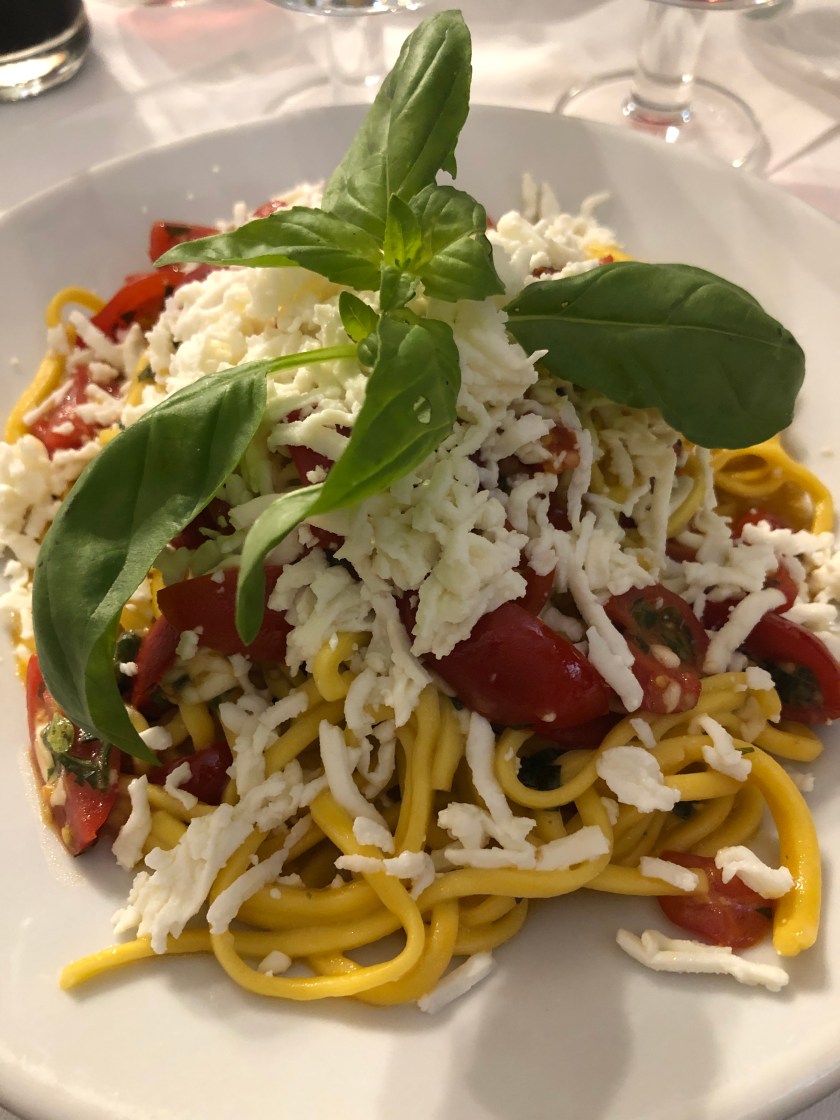
After dinner it was on to one of the best gelaterias in Rome – Gelateria Giolitti [see http://www.giolitti.it/en/]. This famous Roman landmark has been around since 1900! Coincidentally right now I happen to be reading a cool book [no pun intended] about the development of ices etc in history – starting in Florence in the 16th century when the well-to-do began to put ice in their wine to keep it cool in summer. This involved carting snow & ice down from the mountains & keeping it all year round in insulated pits. They also did this in Turkey in the early 16th century. Later the practice spread to Spain & France & even later ppl got more creative with frozen desserts when they discovered that adding salt to water altered its freezing point. Gelato & ice-cream were born! I am currently reading a book on the history of gelato & ice-cream. [See ‘Harvest of the Cold Months: The Social History of Ice and Ices‘ by Elizabeth David. It is available on amazon.com on Kindle] Apparently according to my ex-Roman colleague, Franco Pestilli, the Roman style of eating gelati includes having whipped cream placed between the two gelato flavors, as well as on the top. Had never had it like that before – the cream was really light & lovely. The place also had lots of scrumptious cakes too… Here are some pics of the place.
Walking around at Rome at night is lovely – the ancient buildings look extra special like this shot of the Pantheon below…
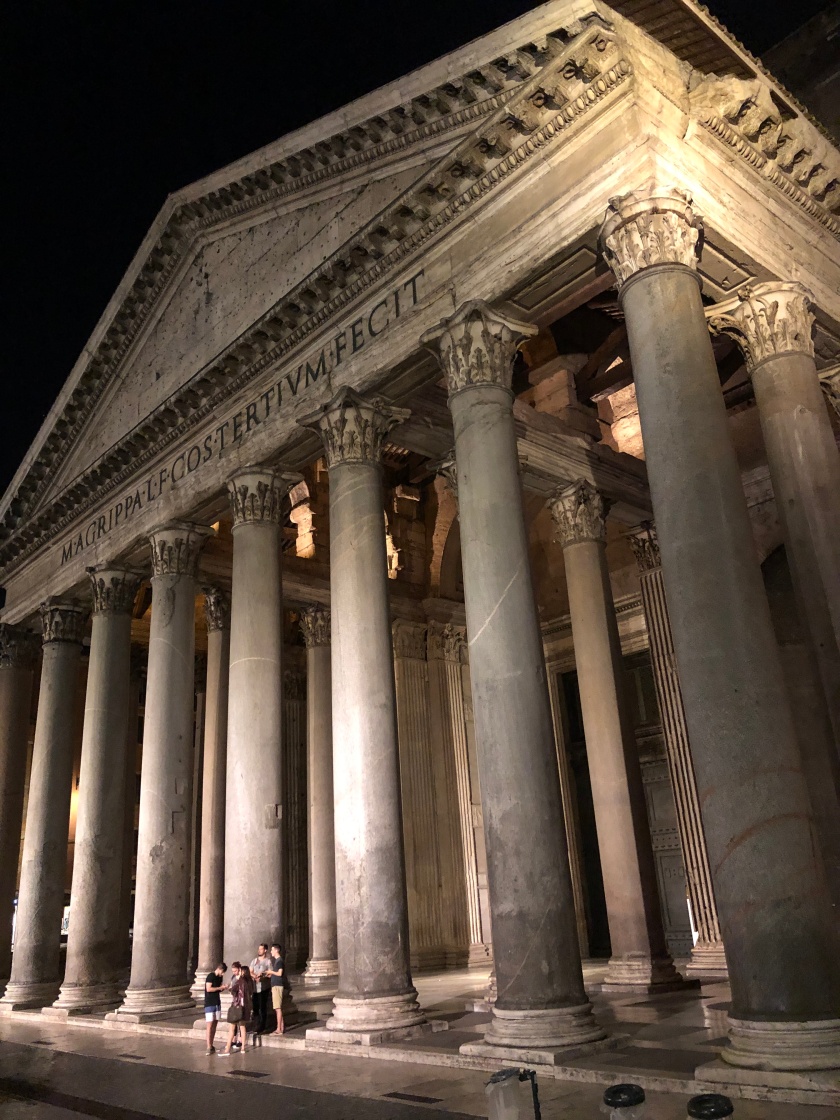
Back ‘home’ to the hotel very late, could barely keep my eyes open… was very tired after the OHBM meeting. Took about 5 seconds to go to sleep…
My memories of this 25th anniversary scientific meeting will be very special for many reasons, including the additional cultural milieu that we were immersed in for the week. Unfortunately, the next day it was arrivederci Roma, but ciao Alto Adige – that will be the subject of the next post or two [which will be shamelessly touristic].





























